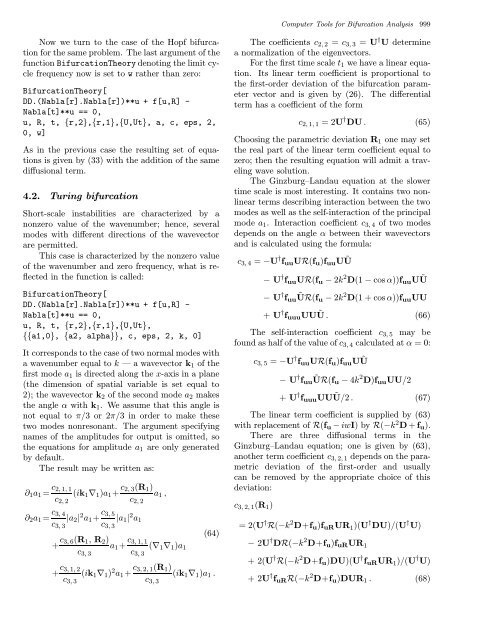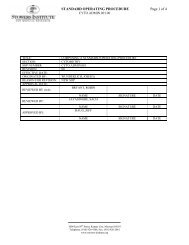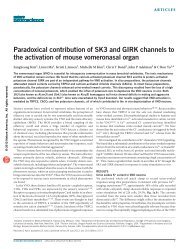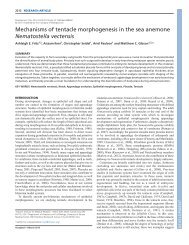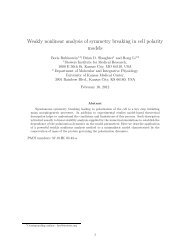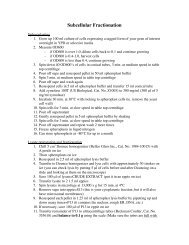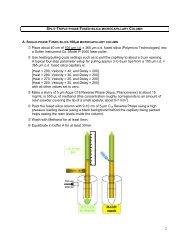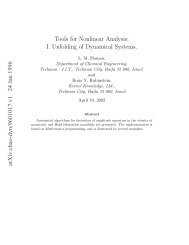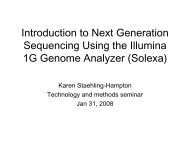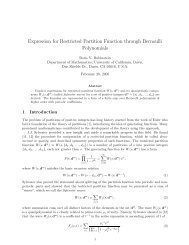Computer Tools for Bifurcation Analysis: General Approach with
Computer Tools for Bifurcation Analysis: General Approach with
Computer Tools for Bifurcation Analysis: General Approach with
You also want an ePaper? Increase the reach of your titles
YUMPU automatically turns print PDFs into web optimized ePapers that Google loves.
<strong>Computer</strong> <strong>Tools</strong> <strong>for</strong> <strong>Bifurcation</strong> <strong>Analysis</strong> 999<br />
Now we turn to the case of the Hopf bifurcation<br />
<strong>for</strong> the same problem. The last argument of the<br />
function <strong>Bifurcation</strong>Theory denoting the limit cycle<br />
frequency now is set to w rather than zero:<br />
<strong>Bifurcation</strong>Theory[<br />
DD.(Nabla[r].Nabla[r])**u + f[u,R] -<br />
Nabla[t]**u == 0,<br />
u, R, t, {r,2},{r,1},{U,Ut}, a, c, eps, 2,<br />
0, w]<br />
As in the previous case the resulting set of equations<br />
is given by (33) <strong>with</strong> the addition of the same<br />
diffusional term.<br />
4.2. Turing bifurcation<br />
Short-scale instabilities are characterized by a<br />
nonzero value of the wavenumber; hence, several<br />
modes <strong>with</strong> different directions of the wavevector<br />
are permitted.<br />
This case is characterized by the nonzero value<br />
of the wavenumber and zero frequency, what is reflected<br />
in the function is called:<br />
<strong>Bifurcation</strong>Theory[<br />
DD.(Nabla[r].Nabla[r])**u + f[u,R] -<br />
Nabla[t]**u == 0,<br />
u, R, t, {r,2},{r,1},{U,Ut},<br />
{{a1,0}, {a2, alpha}}, c, eps, 2, k, 0]<br />
It corresponds to the case of two normal modes <strong>with</strong><br />
awavenumberequaltok— a wavevector k 1 of the<br />
first mode a 1 is directed along the x-axis in a plane<br />
(the dimension of spatial variable is set equal to<br />
2); the wavevector k 2 of the second mode a 2 makes<br />
the angle α <strong>with</strong> k 1 . We assume that this angle is<br />
not equal to π/3 or2π/3 inordertomakethese<br />
two modes nonresonant. The argument specifying<br />
names of the amplitudes <strong>for</strong> output is omitted, so<br />
the equations <strong>for</strong> amplitude a 1 are only generated<br />
by default.<br />
Theresultmaybewrittenas:<br />
∂ 1 a 1 = c 2,1,1<br />
c 2,2<br />
(ik 1 ∇ 1 )a 1 + c 2,3(R 1 )<br />
c 2,2<br />
a 1 ,<br />
∂ 2 a 1 = c 3,4<br />
c 3,3<br />
|a 2 | 2 a 1 + c 3,5<br />
c 3,3<br />
|a 1 | 2 a 1<br />
+ c 3,6(R 1 ,R 2 )<br />
c 3,3<br />
a 1 + c 3,1,1<br />
c 3,3<br />
(∇ 1 ∇ 1 )a 1<br />
(64)<br />
+ c 3,1,2<br />
c 3,3<br />
(ik 1 ∇ 1 ) 2 a 1 + c 3,2,1(R 1 )<br />
c 3,3<br />
(ik 1 ∇ 1 )a 1 .<br />
The coefficients c 2, 2 = c 3, 3 = U † U determine<br />
a normalization of the eigenvectors.<br />
For the first time scale t 1 we have a linear equation.<br />
Its linear term coefficient is proportional to<br />
the first-order deviation of the bifurcation parameter<br />
vector and is given by (26). The differential<br />
term has a coefficient of the <strong>for</strong>m<br />
c 2, 1, 1 =2U † DU . (65)<br />
Choosing the parametric deviation R 1 one may set<br />
the real part of the linear term coefficient equal to<br />
zero; then the resulting equation will admit a traveling<br />
wave solution.<br />
The Ginzburg–Landau equation at the slower<br />
time scale is most interesting. It contains two nonlinear<br />
terms describing interaction between the two<br />
modes as well as the self-interaction of the principal<br />
mode a 1 . Interaction coefficient c 3, 4 of two modes<br />
depends on the angle α between their wavevectors<br />
and is calculated using the <strong>for</strong>mula:<br />
c 3, 4 = −U † f uu UR(f u )f uu UŨ<br />
− U † f uu UR(f u − 2k 2 D(1 − cos α))f uu UŨ<br />
− U † f uu ŨR(f u − 2k 2 D(1 + cos α))f uu UU<br />
+ U † f uuu UUŨ . (66)<br />
The self-interaction coefficient c 3, 5 may be<br />
found as half of the value of c 3, 4 calculated at α =0:<br />
c 3,5 =−U † f uu UR(f u )f uu UŨ<br />
− U † f uu ŨR(f u − 4k 2 D)f uu UU/2<br />
+ U † f uuu UUŨ/2 . (67)<br />
The linear term coefficient is supplied by (63)<br />
<strong>with</strong> replacement of R(f u − iwI) byR(−k 2 D+f u ).<br />
There are three diffusional terms in the<br />
Ginzburg–Landau equation; one is given by (63),<br />
another term coefficient c 3, 2, 1 depends on the parametric<br />
deviation of the first-order and usually<br />
can be removed by the appropriate choice of this<br />
deviation:<br />
c 3, 2, 1 (R 1 )<br />
=2(U † R(−k 2 D+f u )f uR UR 1 )(U † DU)/(U † U)<br />
− 2U † DR(−k 2 D+f u )f uR UR 1<br />
+2(U † R(−k 2 D+f u )DU)(U † f uR UR 1 )/(U † U)<br />
+2U † f uR R(−k 2 D+f u )DUR 1 . (68)


